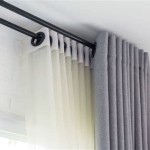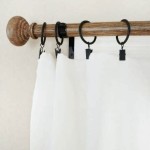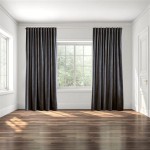How Much Extra Curtain Width Do You Need?
Achieving the perfect drape and fullness for curtains requires careful consideration of width. Simply measuring the window frame isn't enough. Adding extra fabric, known as fullness, creates the desired gathers and prevents a flat, underwhelming appearance. Understanding how to calculate the appropriate extra width is essential for achieving a professional and aesthetically pleasing result.
Understanding Fullness
Fullness refers to the amount of extra fabric used in curtains beyond the width of the window or rod. It dictates how gathered and voluminous the curtains appear. Insufficient fullness results in flat curtains that lack dimension, while excessive fullness can create a bulky and overwhelming look. The ideal fullness depends on the desired look and the type of heading used.
Standard Fullness Ratios
Different heading styles require different fullness ratios to achieve their intended appearance. A general rule of thumb is to use a fullness ratio of 1.5x to 2.5x the width of the window or rod. A 1.5x fullness ratio means the fabric width is 1.5 times the width being covered. A 2.5x fullness ratio means the fabric width is 2.5 times the width being covered. Heavier fabrics and more formal styles typically require a higher fullness ratio, while lighter fabrics and more casual styles can achieve a pleasing look with a lower ratio.
Calculating Required Width
To calculate the required curtain width, first measure the width you want to cover. This might be the window width, the width between the finials on the curtain rod, or even an entire wall. Once you have this measurement, multiply it by your chosen fullness ratio. For example, if you are covering a window 80 inches wide and want a 2x fullness, you will need curtains with a total combined width of 160 inches. If you are using two panels, each panel should be 80 inches wide.
Considering Heading Types
The type of heading significantly impacts the required fullness. Different headings create different folds and gathers, which influence how the fullness is expressed. For example, pinch pleat curtains typically require a higher fullness ratio than grommet curtains to achieve the same level of visual fullness.
Pinch Pleat Curtains
Pinch pleat curtains, known for their tailored and formal appearance, typically require a higher fullness ratio, often between 2x and 2.5x the width being covered. The intricate pleats consume more fabric, necessitating the extra width to achieve proper fullness and drape.
Grommet Curtains
Grommet curtains have a more contemporary and relaxed aesthetic. They typically require a lower fullness ratio, often between 1.5x and 2x. The simple, evenly spaced grommets create soft folds that don't require as much fabric for fullness.
Rod Pocket Curtains
Rod pocket curtains, with their casual, gathered appearance, typically fall within the 1.5x to 2x fullness range. The simplicity of the rod pocket heading allows for a less structured drape, requiring less fabric to achieve fullness.
Tab Top Curtains
Similar to grommet curtains, tab top curtains generally require a lower fullness ratio, typically between 1.5x and 2x. The tabs create a relaxed and informal style, which requires less fullness for a pleasing look.
Fabric Choice and Fullness
The fabric itself can influence the perceived fullness. Heavier fabrics like velvet or damask tend to hang in more defined folds, often requiring a higher fullness ratio. Lighter fabrics such as linen or sheer materials drape more loosely and can achieve a pleasing fullness with a lower ratio.
Achieving Desired Look
Ultimately, the desired look plays a significant role in determining the appropriate fullness. A more formal and luxurious look typically requires a higher fullness ratio, while a more casual and relaxed atmosphere can benefit from a lower ratio. Experimenting with different fullness ratios can help determine the ideal look for a particular space.
Measuring for Multiple Panels
When using multiple panels, ensure the combined width of all panels meets the calculated fullness requirement. Divide the total required width by the number of panels to determine the width of each individual panel. This ensures a balanced and symmetrical appearance across the window or wall.

Curtain Size Calculator

Choosing The Right Curtain Length Ultimate Guide Waterbuckpump

Get Measuring Installation Curtain Label

Curtain Size Calculator

Curtain Size Calculator

Curtain Size Calculator

Off White Linen Curtain Panels With Simple Hem Custom Curtains Extra Wide Farmhouse For Rod Kitchen Gift In India Etsy

Custom Curtains In Family And Bedroom With Curtain Panel Measurement Guide Nesting Grace

Size Guide For Curtains Madura

Net Curtains Measuring Guide Ideal Textiles








